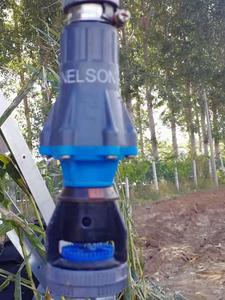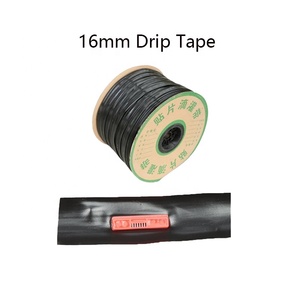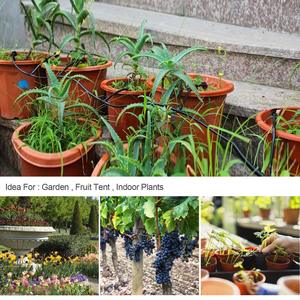(141417 products available)




























































































































































































































































Irrigation systems are designed to supply water to crops and plants in a controlled manner. They help ensure that plants receive adequate moisture, even in dry periods or regions with limited rainfall. These systems can be tailored to meet the specific water requirements of different crops, making them an essential tool for efficient agriculture. Here are some common types of irrigation systems:
Drip irrigation system:
This is a water-saving irrigation system that delivers water directly to the roots of the plants through a network of tubing. It uses drippers or emitters to release water slowly and steadily. This is one of the most efficient types of irrigation systems as it reduces water wastage and is suitable for all types of topography.
Sprinkler irrigation system:
This system sprays water over crops like natural rainfall using pipes, pumps, and sprinklers. It is ideal for sandy soils that lose water through evaporation. There are different types of sprinkler irrigation systems, including stationary, portable, and rotating sprinklers.
Surface irrigation system:
Also known as flood irrigation, this is one of the oldest types of irrigation systems which involves distributing water over the soil surface and letting it flow by gravity to each plant. It is simple and inexpensive but requires land leveling and is less efficient in water use.
Subsurface irrigation system:
This system involves burying drip tubing below the surface of the soil. Water is delivered directly to the root zone, reducing evaporation and allowing for efficient water use. This type of irrigation system is suitable for all kinds of plants and can be used in sandy, loamy, or clay soils.
Manual irrigation system:
This is a simple system where water is carried and poured onto plants manually. It is labor-intensive and not efficient in terms of water use. However, it is inexpensive and can work well in small gardens or farms.
Automatic irrigation system:
These are modern irrigation systems that operate automatically based on set schedules. They often come with timers, sensors, and controllers to start and stop watering at designated times. They save water and reduce the need for manual operation.
Irrigation systems are designed to supply water to plants when there is little or no rainfall. These are the different designs of irrigation systems to consider.
Surface irrigation systems
This is one of the oldest irrigation system designs. Water is applied and distributed over the surface of the soil by gravity. The land is usually sloped to assist the water flow. This type of irrigation is good for crops that require a lot of water and in areas with fine soil that hold water for some time. However, it is not suitable for sandy soils or crops that cannot stand waterlogging.
Drip irrigation systems
Also known as trickle irrigation, this system delivers water directly to the roots of plants using the ""drip"" method. It uses a network of tubing and emitters. It is very efficient and reduces water wastage and evaporation. It is ideal for gardens, orchards, and areas with irregular soil or water supply. The system is expensive to install and maintain, though.
Sprinkler irrigation systems
This irrigation system distributes water like natural rainfall using overhead sprinklers. It consists of a pump, pipeline, and sprinkler heads. It is suitable for almost all types of soils and crops and can be used for both large and small farms. It can be costly and may lead to wind drift and evaporation loss in large systems.
Subsurface irrigation systems
In this system, water is applied below the soil surface using buried drip lines or tubes. It is efficient and minimizes evaporation and weed growth. It is suitable for sandy soils and crops that cannot stand waterlogging. It is, however, expensive to install and may require frequent maintenance.
Manual irrigation systems
This is a system where water is given to plants using the watering can. The farmer does all the work without any machines or equipment. The farmer moves the irrigation water from the source and spreads it over the field. This system is time-consuming and requires a lot of labor. However, it is cheap and easy to understand. It is best for small farms and places where there is little money to spend on machines.
Rainfed irrigation systems
This system stores rainwater in tanks or ponds for later use. It is eco-friendly and reduces water bills. However, it is not reliable in areas with irregular rainfall and can be expensive to set up.
Automated irrigation systems
These are advanced irrigation systems with timers, sensors, and controllers for automatic operation. They save water, reduce labor costs, and provide consistent irrigation. They are, however, expensive to purchase and install.
Irrigation systems are not just for farms. They are used in different areas where proper water management is important. These systems ensure that plants get enough water to grow well, even in places with less rainfall. Here are some key scenarios where irrigation systems play a vital role.
Irrigation in Agriculture
Agriculture is the main use of irrigation systems. Farmers depend on these systems to supply water to their crops, especially in areas with little or no rainfall. Irrigation lets farmers grow their crops all year round, even in dry climates. It raises crop yields, improves quality, and lowers the risk of crop failure due to drought.
Golf Course Irrigation
Golf courses need elaborate irrigation systems to keep the grass and plants healthy. These systems ensure that the course looks good and provides the right playing conditions. Golf course irrigation systems water the grass, trees, and shrubs and create ponds and streams. They use sprinklers, drip lines, and pumps to cover the entire course. The irrigation systems also save water by using sensors and timers to water only when needed.
Landscape Irrigation
Irrigation systems are used in residential and commercial landscaping to maintain plants, lawns, and gardens. Drip irrigation systems deliver water directly to the roots of plants, minimizing water loss and ensuring efficient watering. Sprinkler systems cover larger areas, providing even water distribution for lawns and gardens.
Irrigation in Sports Fields
Sports fields require proper irrigation for optimal playing conditions and healthy turf. Different sports have different turf requirements. For example, football fields can handle more wear and tear than golf courses, which need more precise irrigation. Sprinkler systems are commonly used in sports fields to ensure uniform coverage across the field.
Greenhouse Irrigation
Greenhouses provide controlled environments for plants, and irrigation systems are vital for maintaining optimal growing conditions. Depending on the plants' needs, different irrigation methods are used, such as misting, drip, or hydroponic systems. These systems offer precise water control, enabling year-round plant cultivation regardless of outside weather conditions.
Irrigation in Orchard and Vineyard
Orchards and vineyards require consistent water supply for fruit and grape production. Drip irrigation is commonly used in these scenarios as it delivers water directly to the root zone, promoting healthy growth and minimizing water wastage. It is especially important during fruit development when adequate water is critical for quality yield.
Irrigation for Wildlife Habitat
Irrigation systems help maintain wildlife habitats in arid regions or during dry seasons. Water supply supports plants and animals' needs, ensuring biodiversity and ecosystem balance. These systems provide water for wildlife and help restore and conserve natural habitats. They also aid in managing wetlands and creating water sources for endangered species.
Irrigation in Research and Education
Research and educational institutions use irrigation systems to study water management and train people on irrigation techniques. These systems provide controlled environments for experiments on irrigation methods' effects on crop growth, water conservation, and soil health. They also teach future farmers about modern irrigation technologies, ensuring sustainable agriculture.
Size of Garden
The first factor to consider when choosing the right irrigation system for a garden is the size of the garden. If the garden is small, a simple drip irrigation system will suffice. However, for larger gardens, a more complex sprinkler system that covers all areas of the garden may be needed. It's important to note that the size of the garden can also affect water usage, so keeping this in mind when selecting an irrigation system is crucial.
Type of Soil
The second factor to consider when choosing the right irrigation system for a garden is the type of soil. Different soils absorb water differently, which can affect the efficiency of the irrigation system. For example, sandy soils drain quickly and may require more frequent watering, while clay soils hold water and may need less watering but could benefit from a soaker hose or drip system that delivers water slowly and evenly.
Water Source and Supply
The third factor to consider when choosing the right irrigation system for a garden is the water source and supply. Gardens need a consistent supply of water for proper plant growth, so it's vital to ensure that the irrigation system selected can provide enough water for all its needs. This could mean using tap water, rainwater, or even creating a storage system for groundwater.
Budget
The fourth factor to consider when choosing the right irrigation system for a garden is the budget. There are various types of irrigation systems available, each with its own costs. It's important to choose one that is affordable but still meets the needs of the garden. Sometimes, a higher upfront cost may be worth it if the system is more efficient and requires less water, ultimately saving money in the long run.
Maintenance
The fifth factor to consider when choosing the right irrigation system for a garden is the maintenance. Some irrigation systems require more maintenance than others, which can add to their overall cost. For those who do not have the time or resources to regularly maintain their systems, it may be better to choose a low-maintenance system that does not need constant checking and cleaning.
Q1: What factors should be considered when choosing an irrigation system?
A1: Some factors that need to be considered are the type of crops or plants, soil characteristics, water availability, climate, farm topography, labor costs, and budget constraints.
Q2: How can one conserve water using irrigation systems?
A2: Drip and sprinkler systems can minimize water usage by delivering water directly to plant roots or through controlled sprays. Rainwater harvesting systems and timer-controlled irrigation help in conserving water.
Q3: What maintenance do irrigation systems need?
A3: Regular inspection of pumps, valves, pipes, and sprinklers for damages or leaks should be carried out. Filters should be cleaned, and adjustments must be made to ensure uniform water distribution. Seasonal preparations are essential for the systems.
Q4: Can irrigation systems be automated?
A4: Yes, irrigation systems can use timers, sensors, and automated valves to set schedules and respond to changing water needs based on soil moisture levels.
Q5: What are the trends in irrigation system technology?
A5: The advancements are in precision irrigation, smart controllers, remote monitoring, and drip irrigation technology.